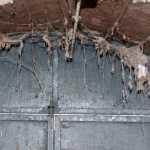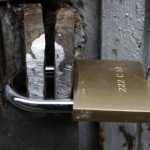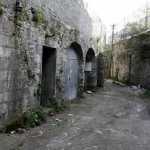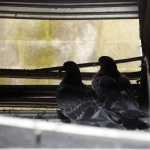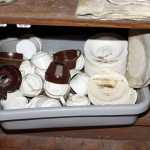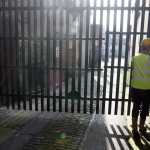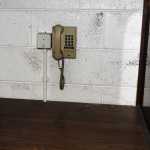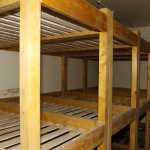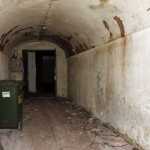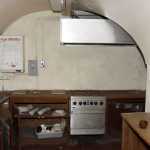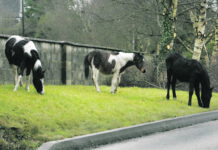Alan Jacques visits Limerick City and County Council’s post-Doomsday nuclear bunker, that is located in an area of the city centre that has been devastated by the economic meltdown.
 “I KNOW not with what weapons World War III will be fought, but World War IV will be fought with sticks and stones,” Albert Einstein envisioned.
“I KNOW not with what weapons World War III will be fought, but World War IV will be fought with sticks and stones,” Albert Einstein envisioned.
If you were a child of the eighties, you may recall that the threat of nuclear holocaust seemed quite palpable and that Reagan or Gorbachev could press that dreaded red button at any given moment and deploy their warheads. Schlocky made for TV films such as 1983’s ‘The Day After’, certainly didn’t help matters, and only served to heighten the apocalyptic nightmares of jittery and impressionable young Frankie Goes To Hollywood fans like myself.
If grim doomsday movies such as ‘Threads’ had gotten it right, then you had to take credence from the old Neil Young saying that it was better to “burn out, than to fade away”.
Truth is, if the Cold War had turned out differently and opposing superpowers actually pushed those red buttons rather than posturing like squabbling roosters, we would no longer be here to ponder that frightful little quandary anyway.
Not the cheeriest of thoughts, but with a ‘bada bing, bada boom’ all humanity would have been annihilated. Those vaporised in the blast, gone before they knew it, would have been better off than the poor souls left behind in shelters to survive in a inhospitable Mordor-like radioactive landscape.
However, not to put too much of a bummer on things, we could at least take some small comfort in the knowledge that our two Mayors and other forward-thinking local councillors along with members of the Council’s senior executive would be safe and sound in the city’s underground lair if such a beastly scenario ever transpired.
From their impervious nuclear bunker, located in an alley off Patrick Street, local government figureheads such as chief executive officer Conn Murray, first citizen Cllr Kevin Sheahan, when not fighting over dibs on top bunk or naming fallen debris after popular American presidents, could formulate cunning plans to rebuild Limerick from scratch.
The Limerick Post this week visited ground zero, to the site where our city fathers would take refuge from the dreaded A-bomb in a meeting of minds for the council meeting to end all council meetings.
Personally, I’d sooner go out in the cataclysmic blast then get landed with that cheery marking, but that’s another day’s work!
As I breathed in the aroma of the day’s first coffee while waiting for my tour guide to take me into the dark bowels of the Council’s end of the world dugout, I had a wry giggle to myself as I thought, “I love the smell of Napalm in the morning”.
With that, dressed in high-vis jacket and hardhat, senior executive engineer Roger Noonan arrives to show me inside Limerick’s nuclear bunker.
“Do you have a torch?” he asks before informing me there is no electricity inside.
An avid horror movie fan, I take news of our impending gloom as an added bonus, but for my accompanying photographer who is literally, shooting in the dark, it poses more practical problems. Roger’s smartphone is the only light we have. Its faint gleam teases us by only revealing momentary glimpses of the bunker’s hidden treasures.
Engulfed in darkness, this Cold War relic, exudes a ghostly and lonely air.
A clock, which hangs on the wall inside the main entrance ominously reveals the time in Tokyo, but has stopped, probably long before the fall of the Berlin Wall.
Cobwebs hang from the ceilings that look like they were spun by giant eight-legged arachnids after a blast of potent gamma rays. While down every dark corridor I keep half expecting brown-shirted stormtroopers to goose-step into me.
I am also struck by the number of telephones. They are everywhere. There’s a communication room full of the things and every wall I pass inside the bunker seems to ruefully brandish one. The telecommunications crew appear to have been overly optimistic when installing them but, God bless them, their glasses were certainly half full.
The bunkroom, capable of sleeping 30 weary heads, is truly creepy. Of course, just like in all great horror movies, it proves the opportune moment for the battery on my guide’s smartphone to die a death leaving us cloaked in thick molasses-like blackness. We are at the far end of the bunker, the furthest point from the exit, when the murkiness swallows us whole.
Carefully clawing our way back to the front of the bunker, with only the eerie cooing of the pigeons for company, I can’t help but think that this would be a fantastic location to shoot a scary movie.
The bunker has fallen into rack and ruin over the last decade. Much like the street it is located off it stands as a sorrowful reminder of the devastating economic bombshell, that wiped out many of the neighbouring businesses.
Now located in the heart of the Opera Centre site, which will be home to 3,000 jobs and a further 300 employed in the construction stage, a new dawn is about to rise on this strange nuclear bunker site.
Famed espionage author John le Carre once wrote, “During the Cold War, we lived in coded times when it wasn’t easy and there were shades of grey and ambiguity”.
Here’s hoping this long derelict part of Limerick city centre will be soon bathed in glorious Technicolor!







